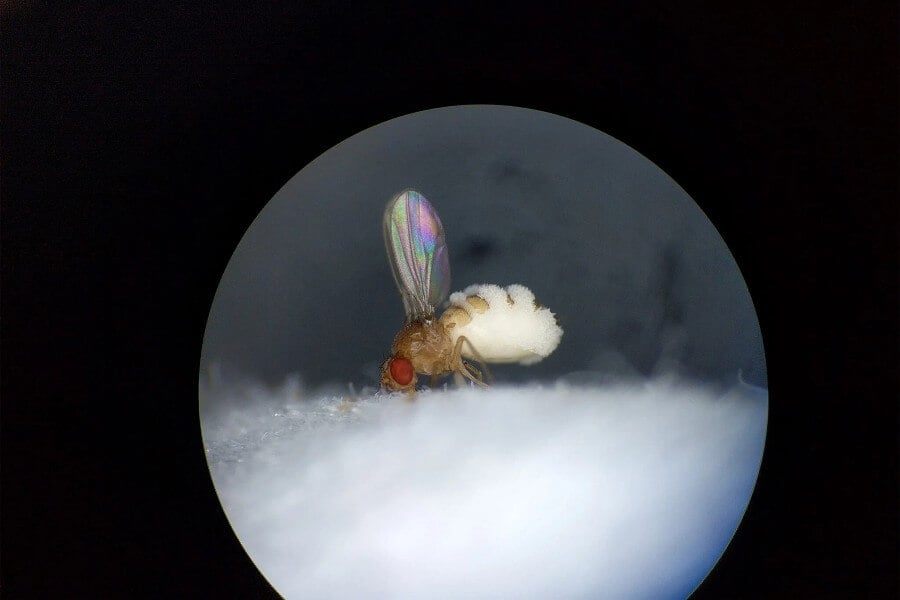The last thing Carolyn Elya expected to find in her backyard were zombies.
Elya was studying microbes carried by wild fruit flies while a graduate student at the University of California, Berkeley. The discovery of some dead ones that had been infected by Entomophthora muscae, a mind-controlling fungal parasite, proved a turning point.
It allowed Elya to closely study how the parasite turns the insects into zombies — and potentially glean more clues into how microbes can affect behavior, a topic that has garnered more popular interest recently with the rise in literature on the human gut biome. (Zombies of various stripes, on the other hand, have been of interest for centuries.)
Elya, who is now a postdoctoral researcher in the Department of Organismic and Evolutionary Biology, recently published some findings from her research in a preprint in bioRχiv.
When she made her discovery, Elya was trying to capture wild fruit flies in her yard for experiments, using rotting fruit as bait. One day, she found some dead flies in a striking pose, with their wings up. Looking more closely, she noticed they also had some material with a banding pattern on their abdomens.
“I ran over to the lab and put them under the microscope. They didn’t look like much, just looked like crusty old flies, but I could see the spores. That got me really excited, and I confirmed that it was Entomophthora by extracting and sequencing some DNA,” she said.
The fungal parasite, whose deadly methods could rival any cinematic horror creature, infects flies, feeds on their bodies slowly from the inside, and then eerily manipulates them into performing a series of specific behaviors at a fixed time of day that will end with them assuming a useful pose (at least for the fungus) before dying.
At sunset, the infected flies climb to an elevated location, called summiting, and extend their proboscises to whatever surface they are on. Sticky droplets that emerge from the proboscis cause the fly to stick to this surface before it lifts its wings and dies. That leaves the fly positioned at an optimal height, with wings out of the way, to allow fungal spores to escape and find a next victim.
Entomophthora muscae and their unfortunate fly victims have been recorded in scientific literature for more than 150 years. Most of the research had focused on house flies. There was no real evidence of the fungus infecting fruit flies — which is significant because so much is known about fruit flies, a laboratory staple.
Elya’s backyard discovery allowed her to set up the first Entomophthora muscae-Drosophila melanogaster “zombie fly” system so the process could be studied. She could now gain unprecedented access to the fly’s brain, helping her delve deep into the mechanistic basis of how the fungus could manipulate the fly’s behavior.
“I really wanted to find out how what circuits are they triggering,” she said. “Scientists have studied the fruit fly for such a long time and developed so many tools that the number of things we can do in flies is just astronomical. It was the ideal system to understand the mechanistic basis of how the fungus manipulates behavior.”
Specifically, Elya has focused on summiting. This effect is also called “summit disease.” In a 2018 study published in eLife, Elya first reported the behavior in zombie fruit flies and found that the fungus invades the flies’ nervous systems during the infection. This led to questions about how the fungus hijacks the nervous system and what neurons are involved.
At Harvard, Elya has robustly quantified “summit disease” for a more thorough understanding of how it is elicited. She also leveraged the fruit-fly system to target specific neurons and uncovered the possible circuit in the host that leads the fly to go to an elevated location at sunset.
She found that silencing a specific set of circadian neurons (DN1p) and the neurons from a region they were known to project to (PI-CA) diminishes summitting behavior. She also found that the fungus takes up residence in the brain very close to these neurons. She hypothesized that the fungus must be secreting something to affect these neurons.
After studying the flies’ hemolymph, or blood, she found certain differences between the infected and uninfected flies. And when she transfused the infected hemolymph into uninfected flies, lo and behold, they began to summit. It is likely that the fungus could be hijacking the fly’s neurosecretory system to manipulate its neurons, Elya theorized.
“There is a lot that we don’t know yet. We don’t yet know how the neurons are triggered to be active in the context of summitting.” Her experiments indicate that something circulating in the blood triggers summiting, but what that is remains unclear. “It could be that the fungus secretes [the summit-inducing factor], or the fungus causes the flies to secrete it themselves,” she said.
The timing of her work has been fortuitous in terms of popular culture. Zombies have been a mainstay for a while, but there is renewed interest owing to the recent hit TV show “The Last of Us,” a dystopic drama about a fungus infestation that turns humans into zombies. In fact, Elya has participated in a Reddit AMA (Ask Me Anything) as an expert on the science behind it.
Elya plans to continue her work. “Developing transgenics for the fungus would be very useful, because if we can modulate things from both the fly side and the fungus side, we can really demonstrate causality and test our understanding of how these processes work.”
Understanding how such a “villain” works can give us a glimpse into how these tiny microbes are capable of extraordinary and seemingly even impossible feats like mind control. “Personally, I never see the fungus as the villain,” she said. “It’s just doing what it needs to do to survive!”

